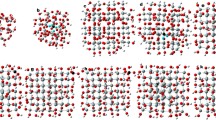Abstract
Quantum confinement in nanoscale Si structures is widely believed to be responsible for the visible luminescence observed from anodically etched porous silicon (por-Si), but little is known about the actual size or shape of these structures. Extended x-ray absorption fine structure data from a wide variety of por-Si samples show significantly reduced average Si coordination numbers due to the sizable contribution of surface-coordinated H. (The H/Si ratios, as large as 1.2, were independently confirmed by ir-absorption and α-recoil measurements.) The Si coordinations imply very large surface/volume ratios, enabling the average Si structures to be identified as crystalline particles (not wires) whose dimensions are typically <15 Å. Comparison of the size-dependent peak luminescence energies with those of oxidized Si nanocrystals, whose shapes are known, shows remarkable agreement. Furthermore, near-edge x-ray absorption fine structure measurements of the nanocrystals shows the outer oxide and interfacial suboxide layers to be constant over a wide range of nanocrystal sizes. The combination of these results effectively rules out surface species as being responsible for the observed visible luminescence in por-Si, and strongly supports quantum confinement as the dominant mechanism occurring in Si particles which are substantially smaller than previously reported or proposed.
Similar content being viewed by others
References
For example, see Mater. Res. Soc. Proc. 256 (1992); 283 (1993); 298 (1993).
L. T. Canham, Appl. Phys. Lett. 57, 1046 (1990)
V. Lehmann and U. Gösele, Appl. Phys. Lett. 58, 856 (1991)
S. Schuppler, S. L. Friedman, M. A. Marcus, D. L. Adler, Y.-H. Xie, F. M. Ross, T. D. Harris, W. L. Brown, Y. J. Chabal, L. E. Brus, and P. H. Citrin, Phys. Rev. Lett. 72, 2648 (1994).
See, e. g., C. Delerue, G. Allan, and M. Lannoo, Phys. Rev. B 48, 11024 (1993), and references therein.
A. A. MacDowell, T. Hashizume, and P. H. Citrin, Rev. Sci. Instr. 60, 1901 (1989).
P. A. Lee, P. H. Citrin, P. Eisenberger, and B. M. Kincaid, Rev. Mod. Phys. 53, 769 (1981).
A. Erbil, G. S. Cargill, R. Frahm, and R. F. Boehme, Phys. Rev. B 37, 2450 (1988). Escape depths have been crudely estimated by multiplying by 5 to account for the 80% porosity.
Preparations of the por-Si samples studied here (referred to as A, B, C, and D) follow those in Refs. 2, 10, and 11, namely, C [2]: p-type Si(100), >50 Ω-cm, 20%HF in alcohol, 20 mA/cm2 for 5 min; A [11]; same as C, but etched 60 min; B [10]: p-type Si(100), >50 Ω-cm, 15%HF in alcohol, 25 mA/cm2 for 12 min; D [11]: p-type Si(100), 0.5-0.8 Ω-cm, 40% HF in alcohol, 50 mA/cm2 for 80 sec, soaked 2 hr unetched in same solution.
S. L. Friedman, M. A. Marcus, D. L. Adler, Y.-H. Xie, T. D. Harris, and P. H. Citrin, Appl. Phys. Lett. 62, 1934(1993).
Y. H. Xie, M. S. Hybertsen, W. L. Wilson, S. A. Ipri, G. E. Carver, W. L. Brown, E. Dons, B. E. Weir, A. R.Kortan, G. P. Watson, and A. J. Liddle , Phys. Rev. B 49, 5386 (1994); Y.-H. Xie (unpublished).
Oxidized Si nanocrystals were made by homogeneous nucleation in high-pressure He at 1000°C from thermal decomposition of disilane with subsequent oxidation in O2 at 1000°C for ~30 msec. See K. A. Littau, P. J. Szajowski, A. J. Muller, A. R. Kortan, and L. E. Brus, J. Phys. Chem. 97, 122 (1993); W. L. Wilson, P. J. Szajowski, and L. E. Brus, Science 262, 1242 (1993); P. J. Szajowski and L. E. Brus (unpublished).
Like the nanocrystals, the por-Si sample also consists of small particles whose band structure is not fully developed, and therefore exhibits neither the larger white-line to edge-jump ratio nor the split white-line structure of c-Si. Our results are completely unaffected by this choice because only difference spectra are being compared.
Densities and molecular weights for bulk c-Si, SiO2, and SiO were used, i. e., 2.33, 2.4, and 2.1 gm cm−3 respectively.
It should be noted that while the outer diameters of the nanocrystals, determined by TEM in Ref. 12, have very conservative error limits of ≲20 %, the relative mass fractions, determined by NEXAFS, are much more precise. Thus, the relative error limits of the inner diameters and the oxide layer thicknesses are just the same as for the outer diameters.
L. E. Brus, P. F. Szajowski, W. L. Wilson, T. D. Harris, S. Schuppler, and P. H. Citrin, J. Amer. Chem. Soc. (to be published).
R. A. Street, Hydrogenated Amorphous Silicon (Cambridge University Press, Cambridge, 1991).
The volumes used for integrating the measured SiHx concentrations in the por-Si samples were obtained from TEM.
Surface sensitivity of <1μm was obtained using a grazing internal incidence angle in a Ge plate positioned next to the por-Si samples.
For a Si cube of side L, NSi = 8L 3/a 0 3; for a sphere of diameter L, NSi sph = (π/6)NSi cube.
Author information
Authors and Affiliations
Rights and permissions
About this article
Cite this article
Schuppler, S., Friedman, S.L., Marcus, M.A. et al. X-Ray Absorption Spectroscopy from H-Passivated Porous Si and Oxidized Si Nanocrystals. MRS Online Proceedings Library 375, 113–120 (1994). https://doi.org/10.1557/PROC-375-113
Published:
Issue Date:
DOI: https://doi.org/10.1557/PROC-375-113




